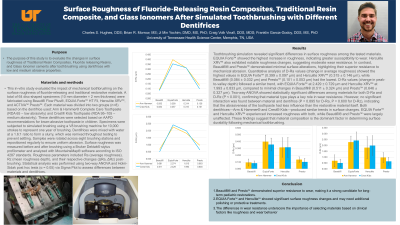Restorative
Toothbrushing Wear of Fluoride-Releasing Resin Composites and Glass Ionomers
76 - Surface Roughness of Fluoride-Releasing Resin Composites, Traditional Resin Composite, and Glass Ionomers After Simulated Toothbrushing with Different Dentifrices


Charles S. Hughes, DDS (he/him/his)
Resident
UTHSC college of dentistry
UTHSC college of dentistry
memphis, Tennessee, United States- CV
Craig Volk Vinall, DDS
Program Director
University of Tennessee Health Science Center (UTHSC)
Memphis, Tennessee, United States
Presenting Author(s)
Program Director(s)
Toothbrushing Wear of Fluoride-Releasing Resin Composites and Glass Ionomers
Purpose: To evaluate the surface roughness effects of pediatric dentifrices on fluoride-releasing resin composite and GI materials using a mechanical toothbrushing simulation.
Methods: Sixteen disc shaped samples each of BEAUTIFIL Flow Plus (Beautifil), Equia Forte (Equia), Herculite XRV (Herculite), and Activa Presto (Presto) were randomly grouped (n=8 Per Dentifrices), according to dentifrice Arm and Hammer Complete Care and Crest Kids. Samples were toothbrushed in a mixture of solutions containing deionized water and dentifrice at 150 gf for 10,000X and rotated to ensure uniform toothbrushing. Surface roughness was measured both before (baseline) and after the mechanical toothbrushing using a stylus profilometer. Roughness data collected (Ra, Rz, D-Ra, and D-Rz) were compared independently for each treatment using two-way ANOVA and Holm-Sidak (P < .05)
Results: Materials Equia and Herculite exhibit the highest changes in both D-Ra (0.399 ± 0.097 μm and 0.315 ± 0.146 μm) and D-Rz (2.429 ± 0.729 μm and 1.993 ± 0.833 μm), indicating greater susceptibility to surface roughness alterations during brushing. Presto shows the smallest changes, implying better resistance to roughness modification. Arm Hammer and Crest Kids generally result in similar trends, but there are slight differences in their impacts depending on the material.
Conclusion: Results suggest that the susceptibility of fluoride-releasing resin composites and glass ionomer materials to surface roughness alterations varies significantly based on material composition. These findings highlight the importance of material selection in clinical applications where resistance to wear is critical, especially in pediatric dentistry.
Identify Supporting Agency and Grant Number:

.jpg)